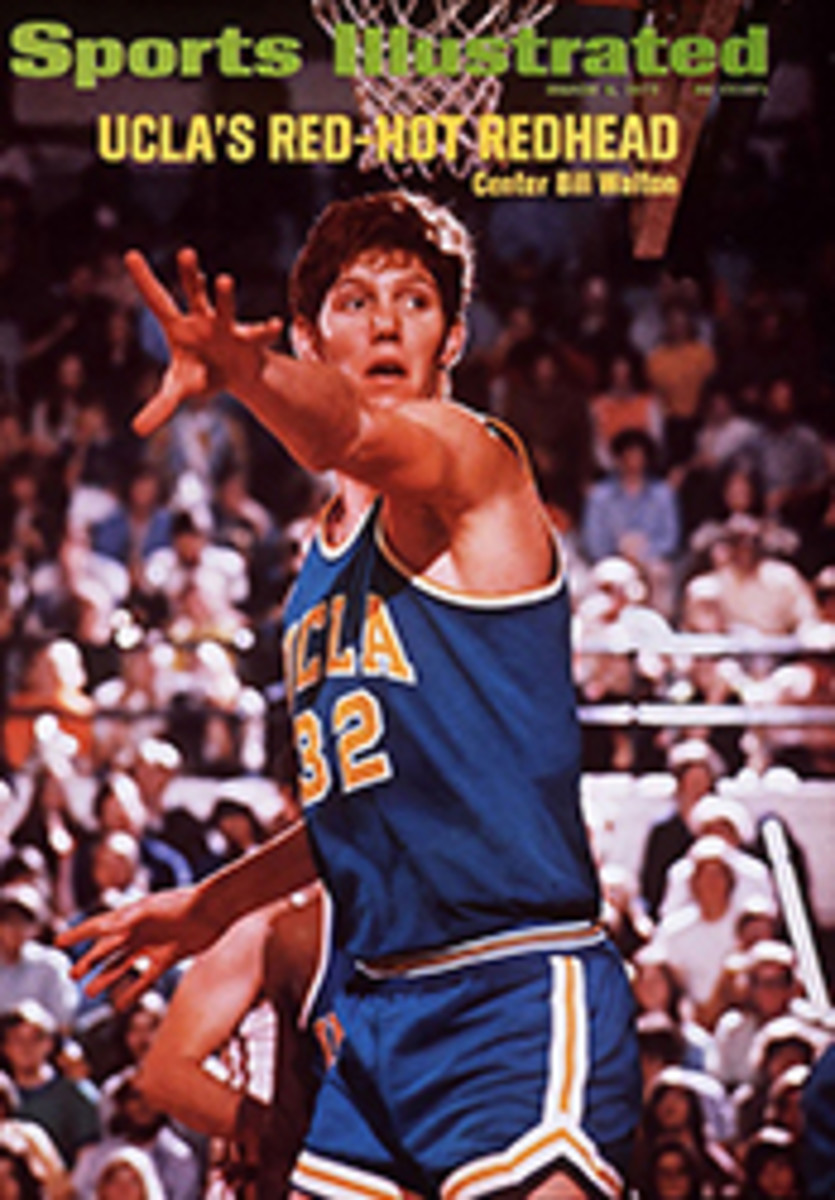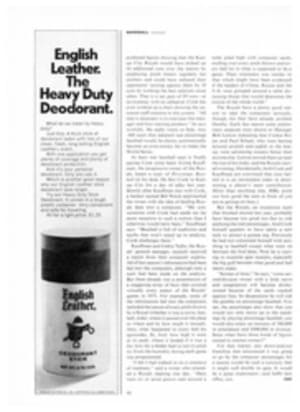
It ain't necessarily so, and never was
For more than a decade Earnshaw Cook, a retired Baltimore metallurgist, has been trying to convince baseball's bosses that playing the sacred percentages is, to be blunt, dumb baseball. In 1964 Cook brought out a 345-page book, Percentage Baseball, that was full of charts, curves, tables and complicated formulas that sometimes went on for the better part of a page. The book dared to suggest that either: a) baseball is not using the best possible odds on the field, or b) mathematics is a fake.
Nothing has happened since to convince Cook that "a" is wrong and "b" is right. "As in the world around us," he says, "baseball offers a completely balanced, highly complicated statistical system, demonstrably controlled in all its interactions of play by the random operations of the laws of chance. As such, it becomes a fascinating illustration of a process readily susceptible to reliable mathematical analysis. Baseball also furnishes a classic example of the utter contempt of its unsophisticated protagonists for the scientific method."
That last sentence is Cook's way of saying that the national pastime thinks he is as nutty as a fruitcake. Since 1964 nobody has dared test out his conclusions even in, say, a winter rookie league. Oh yes, the managers in 1964 were named: Berra, Bauer, Pesky, Lopez, Tebbetts, Dressen, Hodges, Lopat, Rigney, Mele, Kennedy, Hutchinson, Craft, Alston, Bragan, Stengel, Murtaugh, Keane, Mauch and Dark. They all stayed faithful to the memory of Connie Mack—but only Alston is still managing at the same major league shop.
Cook has had some nibbles from the baseball Establishment. The Houston Astros approached him shortly after his book came out and inquired if he thought he could apply his figures in such a way that he could make judgments about minor league prospects. Cook said he would try. He checked the player records Houston sent him, and said that his evaluation indicated the two best prospects were named Jim Wynn and Rusty Staub. This was not bad figuring, as Wynn and Staub are probably still the two best players ever to wear Houston uniforms, but Cook never heard from the Astros again. He also got feelers from the Cubs and Phillies, but nothing came of those.
Ignored, Cook went back to his numbers, and this April his second volume on the subject, Percentage Baseball and the Computer, is scheduled for publication. Basically, it is 207 pages of computer proof that everything he wrote eight years ago was qualitatively correct. Well, not quite everything. The computer has found that Cook's percentage lineup—with the best hitter leading off, the second best batting second, etc.—is, over a season, 12 runs less effective than the traditional lineup.
Otherwise the computer solidly supports the way Cook says baseball should be played. It was no haphazard analysis, either. The computer was programmed to make about 21 possible considerations on every pitch with men on base. Millions of batters came to the plate in the half a million games Cook played with the computer. He was able to do this because a computer never has to go to the resin bag. It can play four games a second, which would put a lot of color announcers out of work. By contrast, a major league manager probably has seen no more than 4,000 games when he comes to the job.
Baseball Establishment people should stop reading this article now, because the heresy is about to begin. Those with more open minds may be interested to know what Cook's computer shows:
•The sacrifice bunt is one of the least productive plays in baseball. The fact that it is negative strategy, says Cook, "is validated beyond reasonable doubt." The computer reports that the sacrifice bunt costs a team 30 runs a year, although that figure is probably even higher now that slick artificial turf has rendered the play even more difficult. Cook sympathetically suggests that managers who would have withdrawal pains giving up the sacrifice should at least prohibit everyone but pitchers from trying it.
•Contrary to all baseball folklore, the time to steal is when there are no outs, not two outs. Over 162 games, a team would have to steal second base 90% of the time to justify attempting to steal with two out.
•In each game, a reliever should start, go two or three innings and come out for a pinch hitter his first time up. He would be followed by a starter type, who would go about five innings, batting the first time he came up, but going out for a pinch hitter his second time up. Another short man would finish the game. This sounds revolutionary, but essentially the only difference is that the "starter" appears in the middle of the game instead of at the beginning.
The normal odds are 3 to 1 against a pitcher throwing a complete game. "So why try?" Cook asks. "To have a shot at a no-hitter? The percentage system—two innings, then five innings, then two innings—not only puts better hitters into the lineup more often, it removes a pitcher before he is likely to get into trouble, not afterward." Two years ago Cook produced figures showing that the Kansas City Royals would have picked up 54 additional runs over the season by employing pinch hitters regularly for pitchers and could have reduced their opponents' scoring against them by 35 runs by working the best relievers more often. That is a net gain of 89 runs—at no expense, with no upheaval. Cook has even worked up a chart showing the optimum staff rotation in this system. "All that is necessary is to convince one manager and four starting pitchers," he says wistfully. He really wants to help. Any .500 team that adopted real percentage baseball would, he claims, automatically become an even-money bet to make the World Series.
At least one baseball man is finally paying Cook some heed. Ewing Kauffman, the progressive owner of the Royals, keeps a copy of Percentage Baseball on his desk. He flew Cook to Kansas City for a day of talks last year. Shortly after Kauffman met with Cook, a banker named Bill Welsh approached the owner with the idea of feeding Royals data into a computer. "My conversation with Cook had made me far more receptive to such a notion than I otherwise would have been," Kauffman says. "Baseball is full of traditions and myths that won't stand up to analysis. Cook challenges them."
Kauffman and Cedric Tallis, the Royals' general manager, recently received a report from their computer experts. All of last season's information had been fed into the computers, although only a start had been made on the analysis. But there already was a presentation of a staggering array of facts that covered virtually every aspect of the Royals' games in 1971. For example, some of the information fed into the computers included the nature of every pitch thrown by a Royal (whether it was a curve, fastball, slider; where it passed over the plate or where and by how much it missed). Also, what happened to every ball hit (grounder, fly, foul; how high it went at its peak; where it landed if it was a hit; how far a fielder had to run to catch it). Even the humidity during each game was programmed.
"I felt I had walked in on a conclave of madmen," said a writer who attended a Royals meeting one day. "Here were six or seven grown men around a table piled high with computer cards, mulling over every pitch thrown and every ball hit in what is supposed to be a game. Their intentness was similar to that which might have been evidenced if the leaders of China, Russia and the U.S. were grouped around a table discussing things that would determine the course of the whole world."
The Royals have a pretty good reason to take the computers seriously, though, for they have already profited thereby. Early last season some preliminary analyses were shown to Manager Bob Lemon indicating that Cookie Rojas and Paul Schaal, who were batting around seventh and eighth in the lineup, were advancing runners better than anyone else. Lemon moved them up near the top of his order, and the Royals started winning. (Incidentally, both Cook and Kauffman are convinced that runs batted in is an incomplete index in determining a player's team contribution. More than anything else, RBIs point out how good the men in front of you are at getting on base.)
But the Royals, an expansion team that finished second last year, probably have become too good too fast to risk applying the real percentages. And Cook himself appears to have taken a new tack to attract a guinea pig. Previously he had not concerned himself with anything in baseball except what went on between the foul lines. Now he is starting to examine gate receipts, especially the big gulf between what good and bad teams make.
"Sooner or later," he says, "some second-division owner with a little nerve and imagination will become disillusioned because of the cards stacked against him. In desperation he will risk the gamble on percentage baseball. You see, the percentages also show that you would not only move up in the standings by playing percentage baseball, you would also enjoy an increase of 200,000 in attendance and $500,000 in revenue. Since when have those kinds of figures ceased to interest owners?"
For that matter, any down-and-out franchise that announced it was going to go by the computer percentages for a season would be such a curiosity that it might well double its gate. It would be a great experiment—and boffo box office, too.

